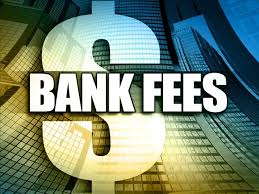Banks and Fees: They Go Together
 That little extra twinge you feel when you tote up your bank account is likely the added fees you pay for the privilege of banking. Typically, there may be some you didn’t even know about. Banks, according to a Market Watch article in the New York Times, aren’t always up front about such things.
That little extra twinge you feel when you tote up your bank account is likely the added fees you pay for the privilege of banking. Typically, there may be some you didn’t even know about. Banks, according to a Market Watch article in the New York Times, aren’t always up front about such things.
The average checking account is subject to some 30 fees, but some institutions have lists of up to 50. That’s according to a 2013 survey by WalletHub.com, a financial website. And, the survey found, about 20 percent of the banks contacted don’t provide prospective customers a list of these charges when they submit an online application. Only two of the banks included in the survey earned perfect scores on the WalletHub quest for full transparency. Fewer than half – 48 percent – had direct links on their product pages to alert customers to the full gamut of fees.
It may or may not make you feel better to know that airlines are worse, with up to 150 potential fees. The list for banking fees is long an varied but may include a fee simply to have a checking account. (In 2009, some 76 percent of banks offered free checking. By 2013, the number was down to 39 percent.) Then, you may pay a fee to use a competitor’s ATM. And the list goes on.
Some of the fault lies with banking consumers. Only one in three makes the kind of annual assessment that would advise them of the fees they are paying. Only 15 percent reported ever having looked into fees at their particular financial institution, Kasasa found when it surveyed 1,000 adults. (Kasasa is a new financial institution devoted to creating communities by uniting small credit unions and small banks.) Federal regulations now require that such information be available, but it’s up to you to find it.
Banks have been more forthcoming in recent years, but there has been a commensurate increase in the number of fees. But to get the information specific to your bank account, you may have to plow through an average 44 pages of information, which still may be incomplete.
Five things to look for:
1. Banks are allowed to change the order of processing checks and electronic transfers. That means that if you have a $50 purchase and another for a minor item (a cup of coffee, perhaps) the larger item is processed first, increasing the bank’s potential to collect overdraft fees on a greater number of smaller purchases. The number of banks that do this has decreased in recent years. About 22 percent of the largest banks no longer do it and the percentage of those that do has gone from 51 percent to 49 percent.
2. The bank may hold a transfer for several days, increasing the institution’s potential for interest income. It may take several days, for instance, for payments to utilities to clear. For the customer, it may make a difference of only a few cents, but with millions of customers, the bank may see a significant advantage. No federal regulations are in place to force a bank to speedily process your payment.
3. Though many banks have created standard disclosure boxes, financial experts say there still is “vast room for improvement.” Making comparisons bank-to-bank is hard because of the length and different ways of identifying the same fees. Pew’s Model Disclosure Box has been adopted by 56 percent of the country’s banks, making it easier to make comparisons. The Consumer Financial Protection Bureau has proposed such mandated disclosure for prepaid cards, but has announced no plans to do the same for banking accounts.
4. Fees for overdrafts are the bank’s biggest money-makers. Such fees make up 60 percent of their fee income, according to the CFPB. More than half of bank customers don’t even know if they have overdraft protection or what their particular coverage consists of. Recent figures show that the number of involuntary closures of accounts based on overdraft issues is rising. It is possible to opt out of the service, with written confirmation of their choice.
5. About three-quarters of banks will let you go into overdraft at ATMs or at points-of-sale with your debit card. But each such transaction will push your account further into the negative, with a fee charged in each instance. The purchase amount will be pulled from your next deposit, along with the fees. Fees for overdrafts have increased steadily and now stand at $35 to $37 per instance at most banks. A transfer from another account at the same bank (savings, for instance) to cover the overdraft is usually about $10.
There. A word to the wise for those who don’t want to be fee-d to death.